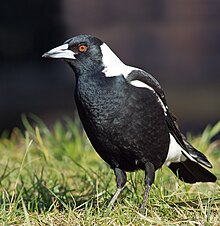| Australian magpie | |
|---|---|

| |
| G. tibicen hypoleuca, Tasmania | |
| Scientific classification | |
| Domain: | Eukaryota |
| Kingdom: | Animalia |
| Phylum: | Chordata |
| Class: | Aves |
| Order: | Passeriformes |
| Family: | Artamidae |
| Genus: | Gymnorhina Gray, GR, 1840 |
| Species: | G. tibicen
|
| Binomial name | |
| Gymnorhina tibicen (Latham, 1801)
| |

| |
| Australian magpie natural range | |
| Synonyms | |
|
Cracticus tibicen | |
The Australian magpie (Gymnorhina tibicen) is a large black-and-white bird. It lives in most parts of Australia and in a small part of New Guinea. It is named after the European magpie, which is also black and white. In Australia, it is just called a “magpie” or “maggie”. Its scientific name is Gymnorhina tibicen.
Australian magpies are related to butcherbirds and currawongs. They live in bush land and in cities near people. They are well known in Australian culture.
Australian magpies are from 37 to 43 cm long. They do not have very long tails like European magpies. They are mostly black, with white on the back of their necks, and under their tails. They have white on their wings that can be seen when they are flying. An adult magpie has red eyes, black legs, and a white beak with black tip. Young magpies have brown eyes and their chest feathers are less dark. There are nine kinds of magpies (subspecies or races) in different parts of the country. Some subspecies have black backs and some have white.
Other common black-and-white birds in Australia are the butcherbird (or “butcher-bird”) and the magpie-lark (also called “peewee”). Butcherbirds have white chests and are smaller than magpies. Magpie-larks are also smaller, are thinner than butcherbirds, and have a different pattern of black and white markings. Currawongs are bigger than magpies and are mostly black. Magpie-larks are not related to the family of magpies, butcherbirds, and currawongs.
They walk on the ground where they look for insects and lizards to eat. Many other birds hop (move with small jumps), but magpies walk. When they are not looking for food, they stand or perch[a] in trees or on man-made structures.
When magpies have baby chicks in their nests, the adults will “swoop” at nearby people – flying at their heads – to chase them away.
Some people feed magpies by throwing small pieces of meat to them. Magpies can learn to come near humans for food. They do not usually let people touch them.